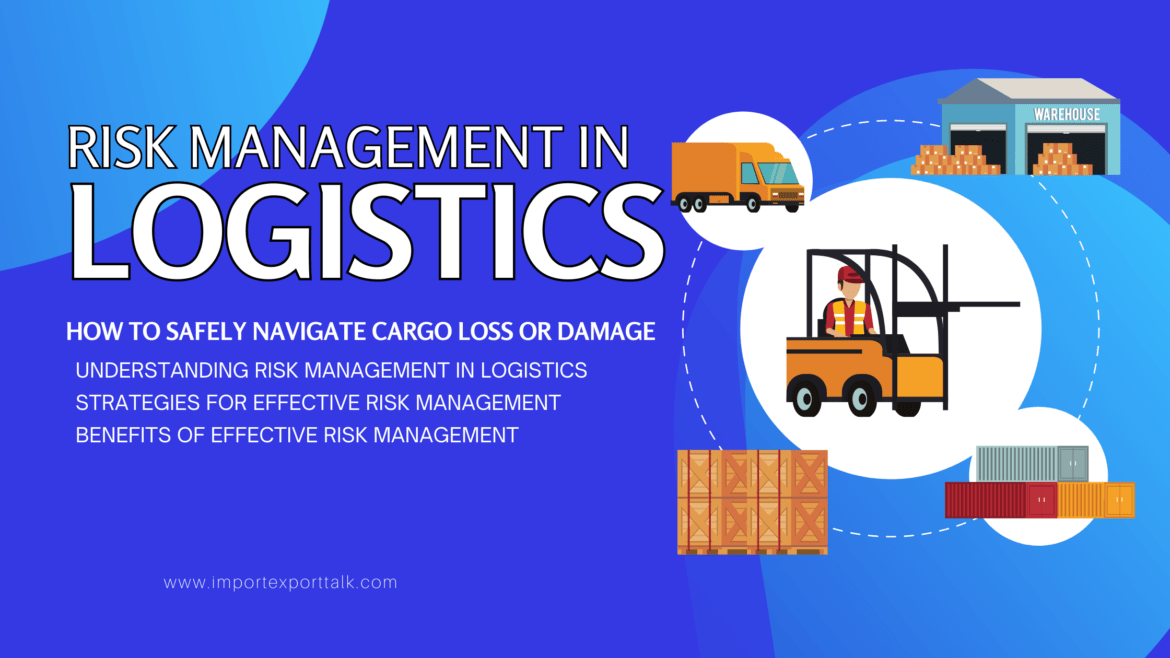Table of Contents
Effective risk management in logistics is the key to mitigating these challenges. In the intricate web of global logistics, the safe transportation of goods is paramount. However, the reality of cargo loss or damage cannot be overlooked. From natural disasters to accidents and theft, various risks can disrupt the smooth flow of goods. Strategies to navigate cargo loss or damage, ensuring secure and successful freight operations.
Understanding Risk Management in Logistics
1. What is Risk Management?
Risk management in logistics involves identifying, assessing, and mitigating potential risks that can lead to cargo loss, damage, or disruptions in supply chains. It’s a proactive approach to minimizing the impact of unforeseen events on the transportation of goods.
2. Types of Risks
- Physical Risks: These include damage due to accidents, collisions, and natural disasters such as storms or earthquakes.
- Operational Risks: Delays, disruptions in transportation routes, or errors in documentation fall under this category.
- Security Risks: Theft, vandalism, and piracy pose threats to cargo security during transit.
Strategies for Effective Risk Management
1. Comprehensive Insurance:
Cargo insurance is a fundamental aspect of risk management. Different types of insurance coverage cater to various risks, including damage, theft, and accidents. Comprehensive insurance policies provide financial protection against unforeseen events, ensuring that any losses incurred during transit are covered. When selecting insurance, it’s essential to understand the coverage limits, exclusions, and claim procedures.
2. Due Diligence in Partner Selection:
Choosing reliable and trustworthy partners in your logistics network is critical. Conduct thorough due diligence on carriers, freight forwarders, and other intermediaries. Check their reputation, track record, and compliance with regulations. Collaborating with reputable partners minimizes the risk of cargo mishandling, delays, and potential disputes.
3. Route and Mode Selection:
Selecting the right transportation routes and modes is crucial for risk mitigation. Some routes may expose cargo to higher risks due to factors like political instability, harsh weather conditions, or crime-prone areas. By analyzing historical data and consulting with experts, you can choose routes that minimize exposure to potential risks. Additionally, opting for secure and reputable transportation modes enhances cargo safety.
4. Proper Packaging:
The packaging of goods plays a significant role in protecting cargo during transit. Ensure that goods are packaged securely and in compliance with industry standards. Fragile or sensitive items require specialized packaging to prevent damage. Adequate packaging not only safeguards cargo from physical harm but also prevents contamination, moisture, and other environmental factors that could lead to losses.
5. Document Accuracy:
Accurate documentation is crucial for the smooth movement of goods across borders. Errors or discrepancies in paperwork can lead to customs clearance delays, fines, or even confiscation of cargo. Double-check all documentation, including bills of lading, invoices, packing lists, and certificates of origin. Accurate and complete documentation ensures that the cargo complies with regulations and prevents unnecessary setbacks.
6. Tracking and Visibility:
Modern technology offers advanced tracking and real-time visibility solutions for cargo. Implementing these technologies allows you to monitor the whereabouts of your goods throughout their journey. Real-time tracking enables you to identify any deviations from the planned route or schedule, enabling you to take immediate corrective actions in case of disruptions.
7. Contingency Planning:
Developing contingency plans is essential to manage unexpected disruptions effectively. Contingency plans outline specific steps to take in case of various scenarios, such as severe weather, accidents, or political unrest. These plans should include alternative routes, emergency contacts, crisis management procedures, and communication protocols. A well-prepared contingency plan helps your team respond promptly and minimize the impact of unforeseen events.
8. Security Measures:
Implementing security measures is crucial to prevent theft, unauthorized access, and tampering. Use tamper-evident seals to secure cargo containers. Choose secure parking areas for trucks during transit breaks. Utilize monitoring systems, such as GPS tracking and surveillance cameras, to enhance cargo security. Implementing these measures deters potential threats and enhances the overall safety of your goods.
Benefits of Effective Risk Management
1. Minimized Loss:
Effective risk management significantly reduces the likelihood and impact of cargo loss, damage, or disruptions. By identifying potential risks and implementing proactive measures, businesses can safeguard their investments and ensure that goods reach their destinations intact. This translates to fewer financial losses due to damaged or lost cargo.
2. Business Continuity:
In the world of logistics, disruptions can lead to delays, missed deadlines, and supply chain interruptions. By having a well-structured risk management strategy in place, businesses can respond swiftly to unforeseen events. Contingency plans, alternative routes, and crisis management procedures ensure the continuity of operations even in the face of challenges.
3. Cost Efficiency:
Investing in risk management strategies may require initial expenditures, but they ultimately lead to long-term cost savings. Effective risk management minimizes the need for expensive recovery efforts, replacements, and legal disputes. It also prevents the financial losses associated with cargo damage or loss, which can be particularly substantial in international trade.
4. Enhanced Reputation:
A business that prioritizes risk management demonstrates its commitment to secure and reliable logistics operations. This commitment resonates with customers, partners, and stakeholders, enhancing the business’s reputation. Clients are more likely to choose companies that have a track record of ensuring cargo safety and timely deliveries.
5. Strategic Planning:
Risk management encourages businesses to adopt a forward-thinking approach. By analyzing potential risks, companies can make informed decisions about routes, partners, packaging, and transportation methods. This data-driven decision-making enhances strategic planning and overall supply chain efficiency.
6. Ethical Responsibility:
Effective risk management also reflects a business’s ethical responsibility toward its clients, employees, and partners. Demonstrating a commitment to the safety and security of goods aligns with ethical business practices and fosters trust within the industry.
Navigating cargo loss or damage requires a comprehensive risk management strategy that addresses various potential challenges. By understanding different types of risks, implementing proactive measures, and investing in appropriate insurance coverage, logistics professionals can ensure the safe and secure transportation of goods across borders.
From due diligence in partner selection to proper packaging, tracking technologies, and contingency planning, every step plays a role in minimizing the impact of unforeseen events. By prioritizing risk management in logistics, businesses can maintain their competitive edge, protect their assets, and contribute to the resilience of the global supply chain.
Understanding the Role of Letters of Credit


4 comments
Risk management in logistics
Logistical Challenges: Buyers with little experience could have trouble arranging transportation and negotiating the customs process. Its crucial to thoroughly arrange the logistics.
Logistical Issues: Logistical difficulties, such port traffic jams, labor disputes, or equipment shortages, can lead to delays and make it
Risk Management in Logistics